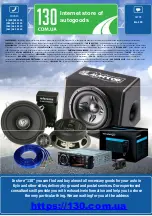
3
before making any adjustments, changing
accessories, or storing power tools. Such
preventive safety measures reduce the risk of
starting the power tool accidentally.
Store idle power tools out of the reach of
children and do not allow persons unfa-
miliar with the power tool or these instruc-
tions to operate the power tool. Power tools
are dangerous in the hands of untrained us-
ers.
Maintain power tools. Check for misalign-
ment or binding of moving parts, breakage
of parts and any other condition that may
affect the power tool’s operation. If dam-
aged, have the power tool repaired before
use. Many accidents are caused by poorly
maintained power tools.
Keep cutting tools sharp and clean. Prop-
erly maintained cutting tools with sharp cutting
edges are less likely to bind and are easier to
control.
Use the power tool, accessories and tool
bits etc. in accordance with these instruc-
tions, taking into account the working con-
ditions and the work to be performed. Use
of the power tool for operations different from
those intended could result in a hazardous
situation.
Battery tool use and care
Recharge only with the charger specified
by the manufacturer. A charger that is suit-
able for one type of battery pack may create
a risk of fire when used with another battery
pack.
Use power tools only with specifically des-
ignated battery packs. Use of any other bat-
tery packs may create a risk of injury and fire.
When battery pack is not in use, keep it
away from other metal objects like paper
clips, coins, keys, nails, screws, or other
small metal objects, that can make a con-
nection from one terminal to another.
Shorting the battery terminals together may
cause burns or a fire.
Under abusive conditions, liquid may be
ejected from the battery; avoid contact.
If contact accidentally occurs, flush with
water. If liquid contacts eyes, additionally
seek medical help. Liquid ejected from the
battery may cause irritation or burns.
Service
Have your power tool serviced by a quali-
fied repair person using only identical re-
placement parts. This will ensure that the
safety of the power tool is maintained.
Safety Rules for Circular Saws
Cutting procedures
Keep hands away from
cutting area and the blade.
Keep your second hand on auxiliary han-
dle, or motor housing. If both hands are
holding the saw, they cannot be cut by the
blade.
Do not reach underneath the workpiece.
The guard cannot protect you from the blade
below the workpiece.
Adjust the cutting depth to the thickness
of the workpiece. Less than a full tooth of the
blade teeth should be visible below the work-
piece.
Never hold piece being cut in your hands
or across your leg. Secure the workpiece
to stable platform. It is important to support
the work properly to minimize body exposure,
blade binding, or loss of control.
Hold the power tool by insulated gripping
surfaces only, when performing an opera-
tion where the cutting tool may contact
hidden wiring. Contact with a “live” wire will
also make exposed metal parts of the power
tool “live” and could give the operator an elec-
tric shock.
When ripping, always use a rip fence or
straight edge guide. This improves the accu-
racy of cut and reduces the chance for blade
binding.
Always use blades with correct size and
shape (diamond versus round) of arbor
holes. Blades that do not match the mount-
ing hardware of the saw will run eccentrically,
causing loss of control.
Never use damaged or incorrect blade
washers or bolt. The blade washers and bolt
were specially designed for your saw, for op-
Read all safety warnings and all instructions.
Summary of Contents for CSM180
Page 47: ...47 Notes Remarques Notas ...




































